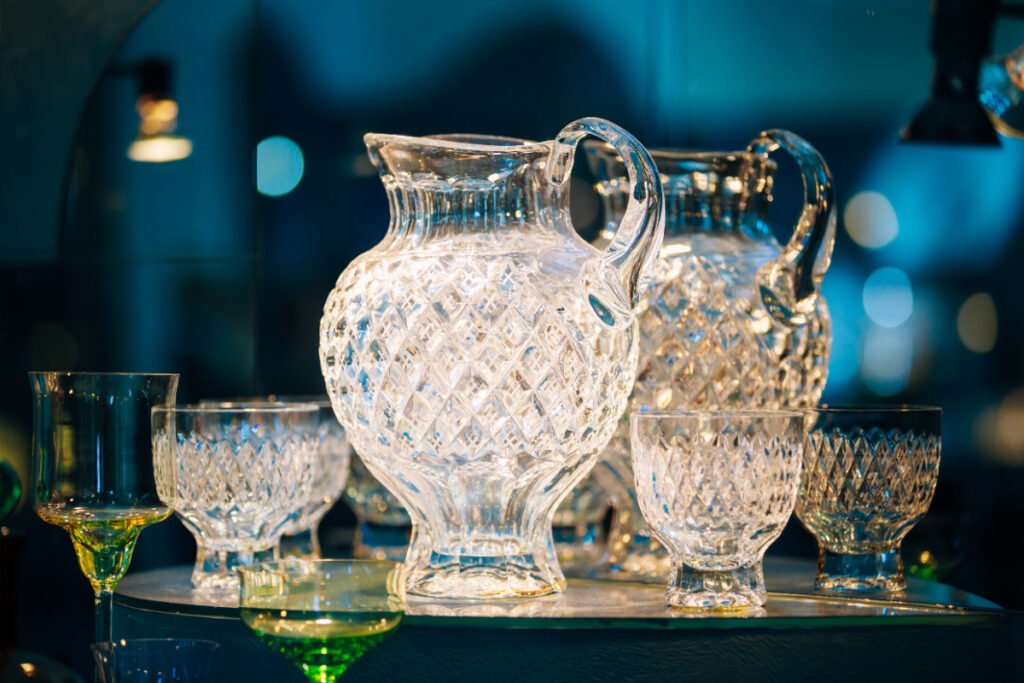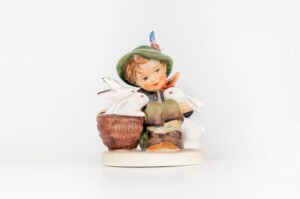If your heirloom is glass, it sets your inner Sherlock Holmes on fire! Well, it’s no joke! I know people confuse old glass for crystal, ending up paying more than they should! So, you might suffer a scam with antiques like glass pitchers!
But what if we tell you that you can easily identify an antique glass pitcher and even value it yourself? Well, that’s right! You just need to know the basic features, dates, and value tables. And I am ready with it all! So, just get a notepad, and let’s do it!
Key Takeaways
- To identify a real antique glass pitcher, look for bubbles, pontil marks, or hand-carved designs on the surfaces.
- Pick transparent or white glass pitchers for high returns. But if you like it colored, you can go with green, amber, cobalt and yellow ones too!
- Step up from the jug-like forms and get barrel, cylindrical or spherical pitchers for the best value. If possible, pick branded designs for more value!
- You don’t have to purchase a cut glass pitcher every time. You can also go for fancy milk or depression glass for more variety.
Key Identification Features of Antique Glass Pitchers

Imagine a cut glass pitcher with local motifs and raised heads. That’s how antique pitchers look! You’ll even see some depressed, pressed, or opal glass finishes with them.
But valuing the pitcher, just by the glass, sounds hard, right? So, here are other features to check:
- Bubbled surfaces and pontil marks, just like any other old glass bottle
- Cut or pressed glass patterns with clear, green, or amber walls
- 8 – 9 inch tall sides with a 5-inch handle on the sides
- Hand-painted motifs with an artist’s name or mold number below
- Hammered, Textured, or Satin glass finishes with crude, 2-3 mm glasses
A Brief History of Glass Pitchers
The earliest glass pitchers looked just like pots. Look for narrow necks, blown sides, and seams to spot these pitchers. You’ll also see varying heights and crude tops. But there won’t be any lids, so more designs are needed!
In the 1830s, alcohol makers added lids to pitchers. They even tried a three-piece mold pattern that regulated the designs! But this stripped the pitchers of their hand touch, making them cheaper!
The new 1900s pitchers are more polished and bold-colored. They don’t have any pontil marks or textures! Instead, you’ll see tall seams, machine finishes, and abstract designs with them. But since these are mostly factory-made, they’re not rare or costly!
4 Types of Old Glass Pitchers With Values
Glass pitchers have been there since the Medieval era! But what helps track their age and value is their types and uses! So let’s check out the four types of glass pitchers and calculate a basic cost range!
1. Water Pitchers

As the title says, water pitchers are tableware jugs for storing water. They are tall, slender and have an elongated tip for pouring. Plus, many of them have pressed glass designs that help you hold and pour easily.
But water pitchers are pretty thin and untinted. You can still get rare, grayish pitchers for $1500 – 2000. But most will be plain and clear, lowering the cost to $500.
2. Milk Pitchers
Milk pitchers look almost like the water jugs you see today. They are small, portable, and have cut glass designs. You also get them in opaque, white finishes, costing around $1000.
3. Cream Pitchers
Cream pitchers are just like vintage cut glass bowls! Round and geometric, they have a 3-4 mm seam on each side. Also, don’t forget to search for its 4-piece set, including the lid, spoon, and saucer; you’ll get a high value of $400 – 500 with it.
4. Harvest Pitchers
Harvest pitchers are the regular wine jugs in any retro brewery. But they were small and whitish, with a soft satin finish and hand-painted motifs. Plus, these were thin and broke or turned yellow with time. So, they are relatively cheaper, costing $100 – 120.
How to Identify & Value an Antique Glass Pitcher (6 Easy Steps)
Now that you know the basic cost of your glass pitcher, let’s move to the details! Here we’ll study the colors and brands that impact a glass pitcher’s final value!
1. Track Its Manufacturing Date & Age
We all pay some extra bucks for rare, handmade goods, right? The same is true for old glass pitchers! In fact, most 1700s models had hand marks and iris designs that you don’t get today. Isn’t that exciting?
But do you know that even clear, geometric jugs from the 1850s are rare? This is because they had less production due to a lack of machinery! So, you can expect a hybrid, three-mold design costing $300 – 400.
Next are the machine-molded glass pitchers from the 1900s. They are obviously cheaper and easy to get. So, try to get branded pieces for more value!
Read below to learn more cues for dating your product!
How Do You Identify Old Glass Pitchers from the 1700s?
Old glass pitchers from the 1700s look like carved flasks! These small, round, hand-cut pitchers offer a high value of up to $2000. And if you see any abstract tops or swan handles, you can hike the value by $200.
But these models won’t have any logos or brands. So, you can look for patent numbers on the lower rim to track them correctly.
How Do You Know If Your Jug Is from the 1800s?
If you see depressed or pressed glass finishes on your jug, it’s from the 1800s. Most of these feature a half-hand, half-machine body with floral patterns and seams. But they have thin walls, lowering their value to $500 – 1000.
How Do the 1900s Glass Pitchers Look?
Did you notice Victorian designs and machine edges on your glass pitcher? Well, it must be from the 1900s! You can even look for pointed tips and gold rims to verify the model! Once done, you can price it for $100 – 500.
Here are some old glass pitcher patent numbers for reference:
| Year | Age | Patent Number | Old Pitcher Type | Average Valuation |
| 1900s | 123 years | USD76545S | Glass Water Jug | $500 – 600 |
| 1898 | 125 years | USD28282S | Water Pitcher | $800 – 1000 |
| 1900s | 123 years | US1104490A | Milk Jug | $200 – 300 |
Try to get hand-blown, uneven shaped pitchers for an old make.
2. Observe the Pitcher Shape

Bored with the normal, jug-like pitchers? Get an antique one to spice up your table decor! You can get barrel or tumbler pitchers for their round, oblong forms or pick short, spherical shapes from the 1700s. Such curvy shapes fetch a good value of $200 – 600.
And if you love it angular, pick the 1800s squat-cut pitchers. These will also be more affordable, at $60 – 100.
| Glass Pitcher Shape | Average Valuation |
| Barrel or Cask Shaped | $500 – 600 |
| Cylindrical or Tumbler Shape | $300 – 350 |
| Flask (Thin Neck, Round Bottom) | $250 – 300 |
| Spherical & Bulbous | $200 – 300 |
| Short, Squat Cut Pitchers | $100 – 120 |
| Spiral or Flared | $60 – 70 |
| Modern Jug-like | $30 – 40 |
Pick pitchers with odd or swan-shaped handles for a better valuation.
3. Observe the Colors
You probably only see white or transparent pitchers in antique shops. But trust me, precious antique pitchers come in a rainbow of colors! In fact, some exclusive colors, like green or amber, even raise your value by 10 – 12%.
Want to know how each color affects the value of your glass pitcher? Check out the table below!
| Glass Pitcher Color | Average Valuation |
| Transparent, Clear or White | $40 – 60 |
| Green, Jadeite, Lime | $20 – 25 |
| Amber, Straw, Amethyst | $10 – 12 |
| Cranberry, Red, Pink | $5 – 10 |
| Cobalt or Navy | $3 – 5 |
| Orange, Cream or Yellow | $1 – 2 |
Try to get pitchers with a dual or tri-color hint for high returns.
4. Check the Brands

Branded things always catch attention, right? So, if you want a thick, shiny pitcher, get the one signed by ‘Fenton,’ ‘Hazel-Atlas,’ or any such 1900s brands. These pitchers might even come with gold or silver rims, raising the value by 10 -15%.
But how do you know if a glass pitcher is branded? Well, for that, rinse your pitcher and check for logos on its seams or base. If not, note their patent number, and verify it from our list!
Here are some antique glass pitcher brands for your info!
| Old Pitcher Name | Manufacturer | Antique Pitcher Type | Average Valuation |
| Cut Claret Jug | Stevens and Williams | Water Pitcher | $1600 – 1700 |
| Panelled Fine cut Pitchers | EAPG | Cream Pitcher | $90 – 120 |
| Blue Carnival Glass Pitcher | Fenton | Harvest Pitcher | $300 – 350 |
| Florentine Pitchers | Hazel Atlas | Harvest Pitcher | $145 – 150 |
5. Examine the Glass Type
You all must have a pressed or carnival glass pitcher at home already. So, if you want high returns, look for pitchers with are, cut glass, or milk glass walls. Here, you can pick hand-cut or whitish-finish glass for a high value of up to $1000.
And if you want some portable models, go with the Depression glass pitchers from the ‘Great Depression Period.’ These will be comparatively lighter and cheaper too!
Let’s look at the value of some common antique pitcher glass:
| Types of Glass for Antique Pitchers | Average Valuation |
| Hand cut Glass or Hungarian Cut Glass Pitchers | $2000 – 3000 |
| Milk Glass Pitchers | $1000 – 1200 |
| Depression Glass Pitchers | $150 – 200 |
| Carnival Glass Pitchers (Textured & Brownish) | $600 – 700 |
| Opaline Glass Pitchers | $300 – 400 |
| Jumbo Glass Pitchers | $400 – 500 |
Avoid buying pitchers with yellowish or cracked glass as they lose their value by 10 – 15%.
6. Check the Weight
Antique lovers always look for thick-walled, heavy pitchers at auction. So, any glass pitcher that weighs less than 40 ounces is a big no!
Similarly, you’ll get fewer returns if your pitcher has uneven wall thicknesses and steel motifs. In fact, you might get less than $10 for such models!
How Do You Maintain Antique Glass Pitchers?
Maintaining antique glass pitchers is child’s play! Just rinse the pitchers with non-abrasive cleaners, dust them, and spray vinegar for shine. You can also store them in a cool and dry place to save them from mold!
How Can You Tell If a Pitcher Is Glass or Crystal?
Take a soft-edged spoon and bang it lightly on the surface. If the pitcher makes a bell-like ringing sound, it’s definitely glass! Similarly, you can flash a torch and check for a prism effect for glass.
Can Old Glass Pitchers Be Toxic?
Yes, old glass pitchers can get toxic because of their high silicates and lead content. So, I recommend using them just for serving or as decorative tableware.
Not all antique glass pitchers are costly! In fact, it’s only the bulbous, cut-glass pitchers that fetch high returns. But now that you have our guide, you can observe the shape and color and value them yourself! I also recommend checking the logos and dates for accuracy!
And if you want to identify and value more antique glass items like oil lamps, antique medicine bottles, and old perfume bottles, explore my other guides!









